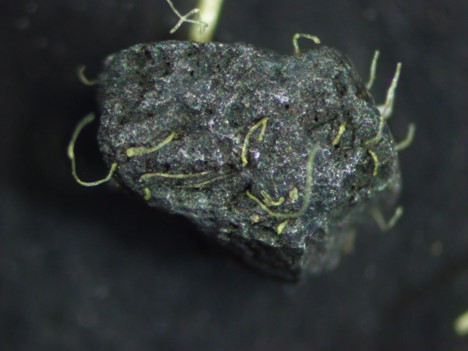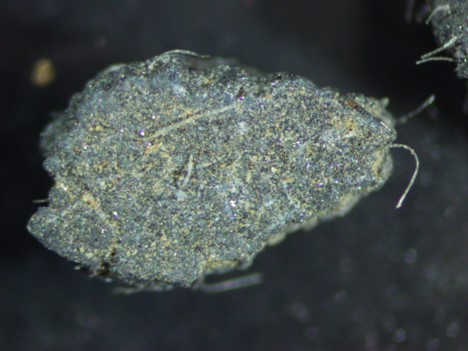Lead Toxicosis, NY
Two herd outbreaks of lead toxicosis occurred in beef cattle in New York in May and June, 2023.
Three angus cattle in the first herd developed bruxism, blindness and seizures after gaining access to old car batteries. The Animal Health Diagnostic Center (AHDC) received post-mortem liver and ante-mortem EDTA whole blood from clinical cows, as well as EDTA whole blood from 10 asymptomatic herdmates. Lead concentrations in blood were all elevated and ranged from 2.94 to 168.5 µg/dL, with a detection limit of 2.5 µg/dL.
The second farmer had been grazing and successfully raising beef animals for years in a pasture, and that pasture held old cars. Three calves under two months of age presented acutely with blindness, grand mal seizures, fevers up to 109 F and death within hours of onset. One necropsy was performed at the AHDC, and pieces of lead battery were identified in the reticulum. Bits of lead battery can easily resemble small pieces of rock or gravel. See Figure 1 below of a lead battery piece removed from the reticulum at necropsy compared to a known lead battery fragment (Figure 2) held in the AHDC Toxicology Laboratory. Additional testing on EDTA whole blood of the two remaining calves revealed elevated lead concentrations of 5.91 µg/dL and 35.61 µg/dL respectively; the second animal became clinical and died later that same day.
Clinical signs of lead toxicosis typically begin at levels greater than 35 µg/dL, although some animals remain asymptomatic at higher concentrations. Therefore, testing lead levels in all potentially exposed cattle is necessary to prevent potential food chain contamination. Lead toxicosis in food animals is reportable in New York State, and animals with elevated lead levels on the premise are quarantined. Blood lead concentrations must be below the limit of detection prior to slaughter. The half-life of lead varies greatly; Bischoff et al1 found a mean of 135 days with a standard deviation of 125 days and a range of 3-577 days. Bone and organ meat often contain higher lead concentrations in comparison to muscle.2
- Bischoff K, Thompson B, Erb HN, Higgins WP, Ebel JG, Hillebrandt JR. Declines in blood lead concentrations in clinically affected and unaffected cattle accidentally exposed to lead. J Vet Diagn Invest. 2012;24:182-7. doi: 10.1177/1040638711425935. Epub 2011 Dec 6. PMID: 22362951.
- Bischoff K, Hillebrandt J, Erb HN, Thompson B, Johns S (2016) Comparison of blood and tissue lead concentrations from cattle with known lead exposure, Food Additives & Contaminants: Part A, 33:10, 1563-1569, DOI: 10.1080/19440049.2016.1230277
Figure 1: Lead battery plate from reticulum (herd 2) at 10x magnification:


Figure 2: Verified lead battery piece, AHDC archive at 10x magnification:



